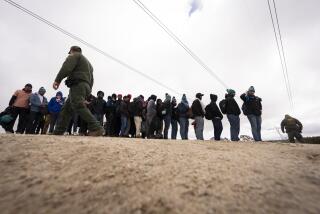Asylum’s broad reach
On first reading, the U.S. 9th Circuit Court of Appeals ruling issued earlier this month seemed absurd: Immigration judges should reconsider whether women from Guatemala constituted a “particular social group” whose members could face persecution simply for being female, in which case they would be eligible for political asylum in the United States.
Wait just a minute, we thought. Sure, Guatemala is a horribly violent country, and sure, we believe in providing sanctuary to the truly persecuted whose governments do not protect them. But could all female Guatemalans really be eligible for asylum as this would suggest? What about Guatemalan men, who are killed at six times the rate of women? Are Guatemalan women really more persecuted than the women of Juarez, Mexico, where about 400 have been killed over 15 years, or those of the Democratic Republic of Congo, where rape routinely has been used as a weapon of war? And how could the United States be expected to absorb millions of women — half the nation of Guatemala — and, by extension, other vulnerable women from all across the globe?
As with so many things, however, this ruling was not quite what it seemed to be. On closer examination, it turned out to be less revolutionary and less sweeping than it had appeared. Though this one is unusually and perhaps impractically broad, it would not be the first time a court considered gender-based asylum claims; judges already had granted this status to women in Africa who fear genital mutilation and those in China who face forced abortions, and even to Guatemalan women who have suffered spousal abuse. More important, even if Guatemalan women were to be deemed a particular social group by the courts, their petitions still would have to be decided on a case-by-case basis. People are not granted asylum just because they belong to a group; they must prove a personal, well-founded fear of persecution and lack of government protection. In short, it was unlikely to open the door to a tsunami of new Guatemalan immigrants.
In 2009, the U.S. granted asylum to 22,119 people. About 25% of them came from China, followed by Ethiopia and Haiti with 5% and 4.5%, respectively, and Guatemala in eighth place with 2.3%, or 513 people. The government tracks applications and adjudication by country, not by reason, and therefore does not have the information necessary to evaluate whether previous designations of a social group have led to significant increases in asylum applications, officials say. Some asylum advocates and former immigration judges say that based on anecdotal evidence — and the experiences of other countries — they don’t think it has.
In most cases, a person seeking asylum in the United States must be in the country already or at a U.S. port of entry to make the request. The president reserves the right to make exceptions, as in the case of Cuba or Iraq. Under international conventions and U.S. law, an asylum applicant must have a well-founded fear of persecution based on race, religion, nationality, political opinion or membership in a particular social group. While the first four groups are relatively easy to identify, courts have struggled to define what constitutes a particular social group. Asylum attorneys have sought to include various threatened groups that don’t neatly fit into the other categories — homosexuals, Romas (or Gypsies, as the courts have called them) and women who may be subjected to violence directed at them solely because of their gender, such as genital cutting. Membership in such a group, assuming the courts accept it, is necessary but not sufficient grounds for gaining asylum.
In this case Lesly Yajayra Perdomo, who came to the United States illegally at the age of 15 to join her mother and was issued a deportation notice 12 years later, argued that she faced persecution if returned to Guatemala, where women are killed at a high rate with impunity. An immigration judge declined to find that she belonged to a particular social group, and the Board of Immigration Appeals rejected her claim that “all women in Guatemala” should be considered a protected social group. The federal appeals court, however, said that was inconsistent with previous opinions by both the immigration board itself and the appeals court, and sent the case back to the lower court to review whether Guatemalan women could indeed be considered “a cognizable social group” and, if so, whether Perdomo could demonstrate fear of persecution “on account of” her membership.
We certainly don’t want to minimize the threats to women in Guatemala, or around the world, for that matter. Generally speaking, women don’t have the political and economic clout or the firepower that men have, and there are plenty of situations in which women are subjected to crimes simply because they are women: spousal abuse, forced marriage, forced sterilizations, sex trafficking and honor killings, to name a few. The problem in this case is that Guatemala is dangerous not just for women but for everyone. The homicide rate for women is somewhat higher in Guatemala than in the rest of Latin America, and that is disturbing. But the homicide rate there last year (which was more than three times Mexico’s) was substantially worse for men than women: 709 women were killed compared with 6,498 men. And though many of the slain men quite likely were involved in gang violence and criminal activities themselves, impunity is rampant across the board — about 98% for the killing of women, according to the U.S.-based Guatemala Human Rights Commission, and just slightly less than that for men.
Too many cultures see violence against women as a prerogative, not a crime. The United States must continue to fight against this and offer protection to the most endangered people, but it cannot be expected to provide refuge to all women at risk. Though it is important to broaden the umbrella to include groups of persecuted people who don’t fall into the prescribed categories, the designation of all Guatemalan women is simply too broad. On points like this, either the U.S. attorney general or the U.S. Congress could help by clarifying what constitutes a protected social group. The solution to the broader problem of violence against women, however, is not just to accept victims into the United States but to forcefully address the cultural biases and lack of justice in the countries where it is taking place. One way to do this would be for Congress to pass the bipartisan International Violence Against Women Act, which seeks to make the issue a priority for the Department of State and the U.S. Agency for International Development. This would direct U.S. support and assistance to educational, economic and other programs that address the root causes of violence against women, and build up rule of law to hold abusers accountable.
More to Read
Sign up for Essential California
The most important California stories and recommendations in your inbox every morning.
You may occasionally receive promotional content from the Los Angeles Times.










